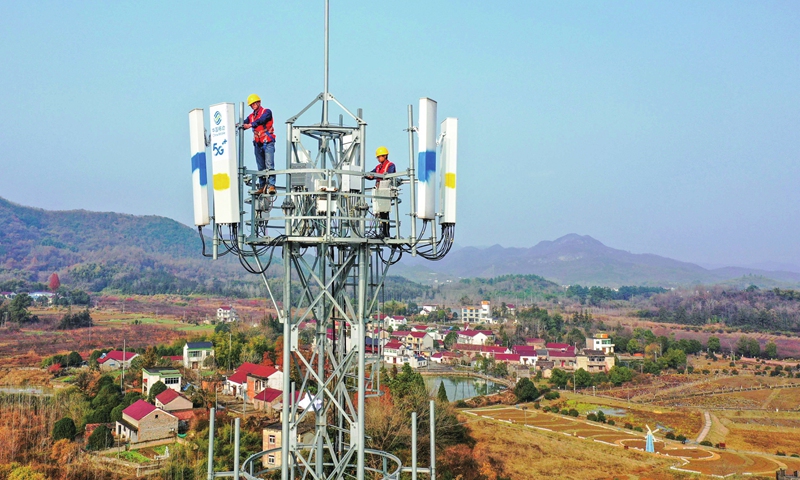
A concept photo of 6G technology Illustration: VCG
As 6G, the next-generation communication technology, is widely expected to achieve commercialization around 2030, various nations are ramping up research and development efforts, despite the absence of clear technical routes or unified international standards.
The next three to five years will be crucial for seizing the high ground in the field and cultivating an industrial foundation, experts said, as they called for close cooperation with international standards agencies and platforms, embracing openness and win-win partnerships.
Amid the ongoing Global 6G Conference, which is being held online from Tuesday to Thursday, more than 100 communication technology experts from China and abroad are discussing the development and vision of 6G, focusing on possible network architecture, wireless transmission routes and other issues.
The revolutionary technology, expected to be 10-100 times faster than 5G in terms of data transmission speed, will integrate with advanced computing, big data, artificial intelligence (AI) and blockchain, set to make up for desired applications that fall short of expectations in the 5G era.
Among the nations that are preparing for 6G, China is taking a leading position based on the huge investment and technological reserves of its mobile operators and equipment makers, industry watchers said.
During its earnings briefing earlier this month, China Unicom executives said that the company attaches great importance to network upgrading and evolution, while carries out tracking and research on 5G-A and 6G technologies.
For equipment providers, Chinese technology giant Huawei began R&D on 6G as early as 2019. In 2020, Huawei joined hands with China Unicom and Galaxy Aerospace for an air-space-ground integration strategic partnership agreement to jointly develop 6G.
"Enterprises are accelerating their forward-looking stances on 6G, but now it is not time for them to disclose their innovational achievements, which are at the initial stage," Ma Jihua, a veteran tech industry analyst, told the Global Times on Wednesday.
"There is not yet a clear technology route and different countries are mainly focused on pushing ahead with their R&D," Ma said, noting that China aims to have a major standard-setting role in the 6G era.
In January, a high-tech lab in Nanjing, capital of East China's Jiangsu Province, announced a major achievement related to 6G-oriented terahertz 100/200Gbps (gigabits per second) real-time wireless communication, which led to the world's fastest real-time transmission for terahertz real-time wireless communication that's been publicly reported.
The achievement has a wide range of prospective applications. It can be installed in satellites, unmanned aerial vehicles and space ships, which can be applied to high-speed wireless communication scenarios between satellite clusters, between the sky and Earth, and between satellites over distances of more than 1,000 kilometers.
Chih-Lin I, chief scientist of China Mobile Research Institute (CMRI), said at the conference that the next three to five years will offer a "window" for 6G technologies, and this period will be key to seizing the technological heights.
She suggested that China should maintain its influence accumulated in international standards organizations in the 3G-5G eras, enhance cooperation with relevant international standards organizations and platforms, and fully promote 6G in the direction of global unified standards and ecology.
"The world is likely to agree on 6G standards around 2028, and from 2020-2025, China will likely focus on proposing 6G standards as well as research of related technologies," Xiang Ligang, director-general of the Beijing-based Information Consumption Alliance, told the Global Times.
"The country will not lag in 6G development at any stage, whether in technical research or infrastructure construction," he added.
The international organization that's involved with telecom technologies - 3GPP - is expected to initiate R&D of 6G international technical standards around 2025 before the expected commercialization around 2030, according to a white paper issued last year by the IMT-2030 (6G) Promotion Group, under the guidance of the Ministry of Industry and Information Technology (MIIT).
China, the world's biggest internet and smartphone market, granted 5G licenses for commercial use and started 6G R&D in 2019. It has built the largest 5G mobile infrastructure in the industry, with 1.43 million 5G base stations rolled out as of the end of 2021, accounting for over 60 percent of the global total.

Network maintenance staffers at the local subsidiary of China Mobile in Tongling, East China's Anhui Province test antennas for 5G base stations on December 13, 2021. As of early December, the Tongling subsidiary had built over 650 5G stations, enabling full coverage in Tongling's rural hot spots. Photo: cnsphoto
MIIT head Xiao Yaqing has vowed to strengthen international telecom cooperation in 5G R&D and applications, and to create a globally coordinated industrial ecosystem for there to be a safe, open and more mutually trusting environment.
China will take part in global efforts to push for common standards and the maturity of new technologies, Xiao told a press conference in February, noting that many Chinese companies including Huawei and ZTE have joined up with other industry peers including Nokia and Ericsson.





